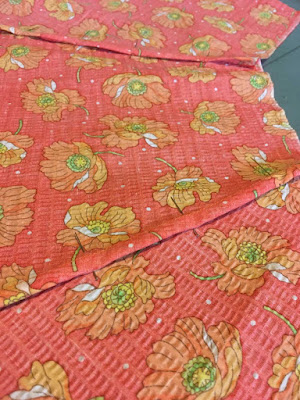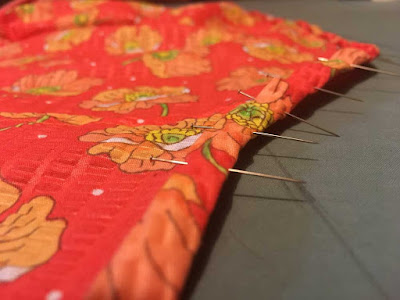Coral Poppy Sundress
 |
| That's a break room napkin. Necessity, invention, etc. |
a) a plan (and a semi-fitted pattern!)
b) more than 36 hours
c) a sewing machine
 |
| I moved the curve at the center back seam to the side seam. No idea how that'll work in the end, but fingers crossed. |
It's hard to see in the photo, but there are eight gores in the skirt, arranged evenly around the waist circumference. I'll be adding pockets and shoulder straps, too, but those didn't make the layout photo.
 |
| Taken after I learned that one should not get too excited about pressing plissé, lest one press out all the delightful texture. Who knew? |
Pressing and pinning the seams was A Pain, though. Plissé is springy and spongy in unexpected ways, and my pinning habits are tuned to handsewing...which is to say, I use relatively few and widely-spaced pins, expecting to be able to fiddle with and correct any fabric wriggles as I stitch. That doesn't really happen when you're using a machine. At least, not on your first-ever project using one.
 |
| Scraps are a great source of lazy bias tape. |
 |
| At last, a photo that shows the true obnoxious saturation of this fabric—that's the back you've been looking at this whole time. |
 |
| With my usual seat-of-the-pants aplomb, plotting the scalloped hem. |
"But Sabine, did you not want a sort of fifties-inspired style to this dress? Does that not imply a certain amount of planning and careful measurement?"
No, why would you think that?
Um, yes, actually, it does, and this photo was taken before I realized that I'd marked my scallops so they fell off the existing hem of the dress, rather than being cut out of it. I fixed that, with a certain amount of swearing, and proceeded to cut a vast number of little scallops out of both hem and extra fabric for facing them. Still didn't really measure them. Still not bothered about it.
 |
| Note the increased pin density. |
You may have noticed this photo is not of a pocket (it's the top bodice binding). That's because pockets, too, are A Rat Bastard, and between it being late and attempting to finish each step as the sense of the instructions trickled through the fevered corners of my brain like superfine sand, I did not pause for photos of any portion of that process. Suffice to say you cut pockety shapes, stitch them in reasonable locations for pocketses, attach them to each other so you don't just have random pockety shapes hanging out in slits in your skirt, try them, discover you've made pockets that will hold approximately zero things because they're too shallow, and stitch up an extra few inches of side seam to correct the problem.
Some of those steps might be optional. I wouldn't know. These are only my third set of pockets ever. (And now "pocket" looks like a fake word to you, too.)
 |
| Nearly constructed! The shape is much better with the center front of the bodice cinched down. |
However, it's very satisfying to have proof that this really does look like a sundress, and it ought to fit well (final judgement reserved for after inserting buttons), and the skirt is nice and full. Also note that it is Not Teal, unlike 64% of my wardrobe, and Neither Is It Black (21% of the wardrobe).
Comments
Post a Comment